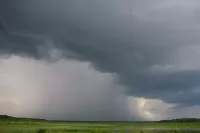Hail is a form of solid precipitation consisting of hailstones, which are balls or irregular lumps of ice. It is often confused with ice pellets, but they are different. Ice pellets typically fall in cold weather, while hail formation is inhibited by low surface temperatures.
1965: Hail suppression programs undertaken by 15 countries
From 1965, hail suppression programs have been undertaken by 15 countries.
2005: Hail suppression programs undertaken by 15 countries
Until 2005, hail suppression programs have been undertaken by 15 countries.
January 2010: US National Weather Service hail diameter threshold increase
In January 2010, the US National Weather Service increased its hail diameter threshold to 1 inch (2.5 cm), up from the previous threshold of 0.75 inches (1.9 cm).
July 29, 2010: Foot of hail accumulates in Boulder County, Colorado
On July 29, 2010, a thunderstorm that was nearly stationary caused a foot of hail to accumulate in Boulder County, Colorado.
2023: Hailstorms cost the United States $46 billion in damage
In 2023, hailstorms in the United States caused $46 billion in damage to cars, roofs, and crops, according to the Insurance Institute for Business & Home Safety (IBHS).
2025: ICECHIP field study begins
In Spring 2025, the "In-situ Collaborative Experiment for Collection of Hail In the Plains" (ICECHIP), the world's largest field campaign devoted to studying hail, began in the United States. The project involves 100 scientists and aims to study hail processes in thunderstorms.
Mentioned in this timeline

Thunderstorms also known as electrical or lightning storms are characterized...
The National Weather Service NWS is a US federal agency...
Colorado a Mountain and Southwestern U S state is the...
Denver is the capital and most populous city of Colorado...
The foot is a crucial anatomical structure present in numerous...
Trending
2 months ago Heavy Downpours and Strong Winds Expected to Impact Boston Commute on Monday
7 months ago US Prepares Partial Iraq Embassy Evacuation Amid Regional Security Concerns: Report

2 months ago Timothée Chalamet discusses having children, Kylie Jenner reportedly hurt by his interview comments.
1 month ago Priah Ferguson discusses girlhood, growth, Stranger Things goodbye, and Erica spinoff possibilities.

2 months ago Florence Pugh Addresses Online Abuse Regarding Zach Braff Relationship and its Impact.
3 months ago Johor Regent Seeks Sale of $2.7 Billion Singapore Land Near Botanic Gardens
Popular

Stranger Things created by the Duffer Brothers is a popular...

XXXTentacion born Jahseh Dwayne Ricardo Onfroy was a controversial yet...
The Kennedy Center Honors are annual awards recognizing individuals and...
Turning Point USA TPUSA is an American nonprofit organization founded...

Candace Owens is an American conservative political commentator and author...

Bernie Sanders is a prominent American politician currently serving as...
